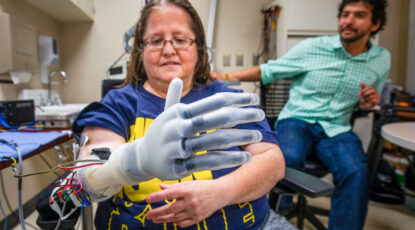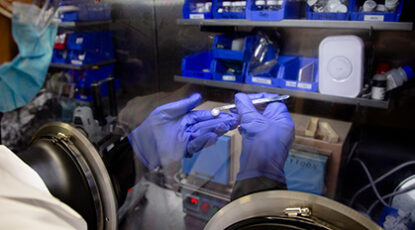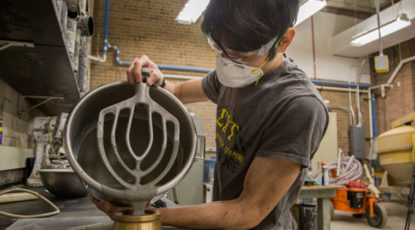-
How to make the robot revolution serve the people
The Ford Robotics Building, at $75 million and 140,000 square feet, is set to open soon. Features include an indoor fly zone for autonomous aerial vehicles, an outdoor playground for walking robots, a high-bay garage for self-driving cars, and more.
-
‘Holy grail’ battery doubles the range of electric vehicles
Lithium metal batteries can double the capacity of today’s standard lithium-ion cells, and much of the existing manufacturing system is primed for production, say experts at U-M. Let’s roll!
-
Live public street cams track social distancing
A University of Michigan startup is tracking social distancing behaviors in real time at some of the most visited places in the world.
-
Producing ‘green methane’ with artificial photosynthesis
A solar-powered catalyst uses artificial photosynthesis to turn carbon dioxide into methane. We could be recycling smokestack CO2 within 5-10 years, researchers say.
-
Peering into biological tissue
A light-spinning device inspired by the Japanese art of paper cutting allows U-M researchers to scan the internal structures of plant and animal tissue without X-rays
-
Easy rider? Not always
After years working in Silicon Valley, Levi Weintraub, BSE ’06, dreamed of ditching his job as a software engineer, hopping on a motorcycle, and exploring Africa. So he did. After logging some 42,000 miles, he says, ‘Humanity was the biggest revelation for me.’
-
Built by humans, ruled by computers
As algorithmic decision-making becomes more powerful, researchers cite concerns that computers don’t always know — or do — what’s best for we humans.
-
Queen of the Hurricanes
Elsie MacGill, MSE ’29, the first female aeronautical engineer trained at U-M, weathered polio to build planes for Britain’s R.A.F.
-
U-M offers road-saving formula: free
Ultra-high-performance concrete promises more durable roads and bridges, not to mention budgets.










